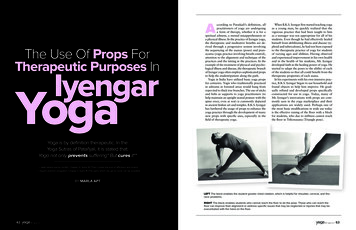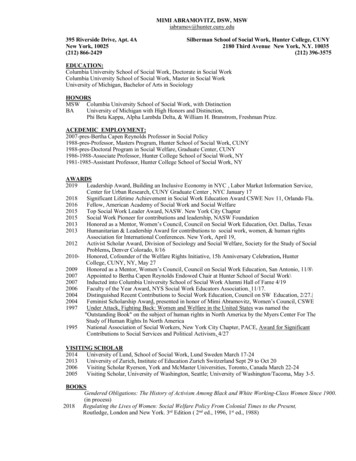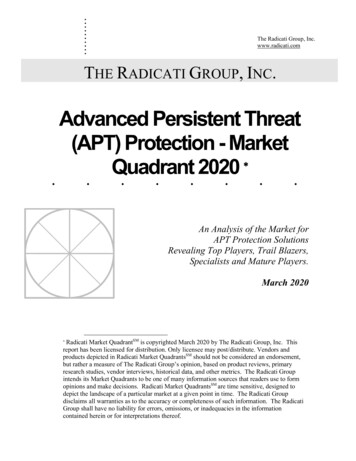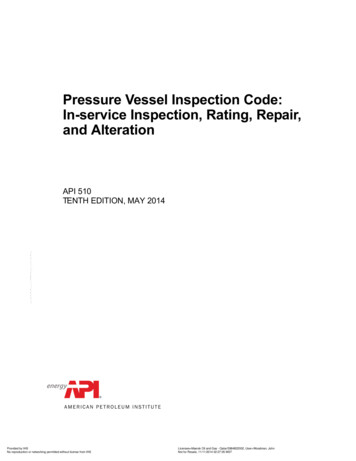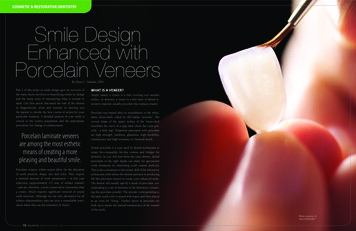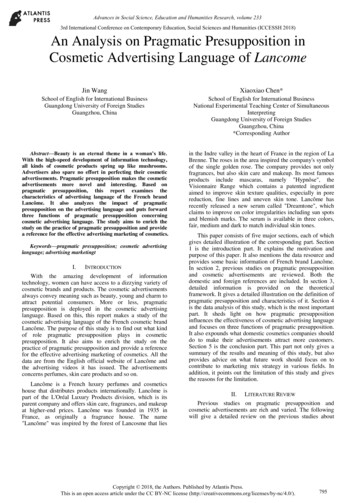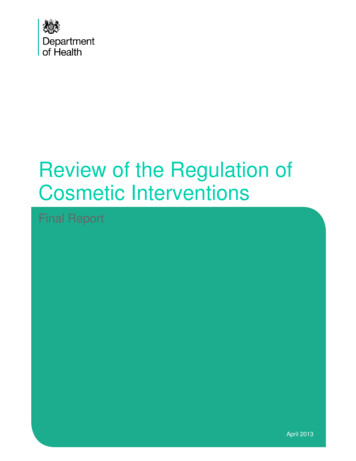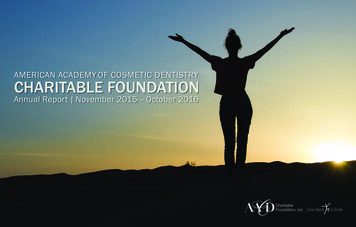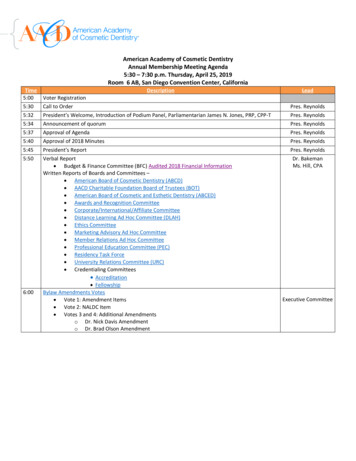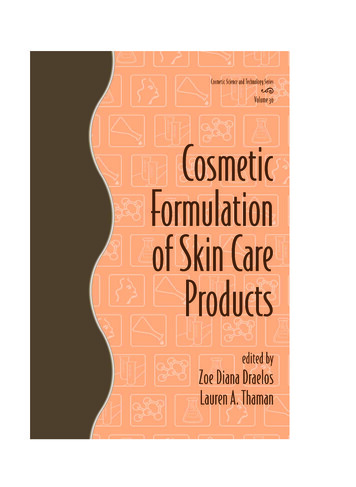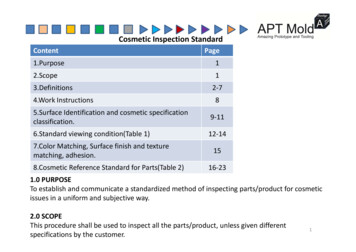
Transcription
Cosmetic Inspection 4.Workk Instructions2‐785.Surface Identification and cosmetic specificationclassification.9‐116.Standard viewing condition(Table 1)12‐147.Color Matching, Surface finish and texturematching adhesion.matching,adhesion8.Cosmetic Reference Standard for Parts(Table 2)1516‐231.0 PURPOSETo establish and communicate a standardized method of inspecting parts/product for cosmeticissues in a uniform and subjective way.2.0 SCOPEThis procedure shall be used to inspect all the parts/product, unless given differentspecifications by the customer.1
3.0 Defect DefinitionsBurn marks: Brown to black, irregular and locally variable discoloration of the molded part,also see gas marks.Gas marks: Dark discolored streaks caused by incomplete venting of gases generatedduring the molding cycle.Short shot(non‐fill): Missing plastic due to incomplete filling of the mold cavity. Parts arenot completely formed, generally at the ends of flow paths or at thin sections, Can usuallyb idbeidentifiedtifi d bby smooth,th shinyhi andd roundedd d surfaces.fSink mark: Surface depression caused by non uniform material solidification andshrinkage most often noted at interface between differing wall thicknesses.shrinkage,thicknessesDistinct, localized hollows in the surface, generally found opposite ribs, at thicker sections,cores, weld lines, constrictions, hot runner nozzles and the end of flow paths.Flash: Excess plastic at parting line or mating surface of the mold, Normally very thin andflat protrusion of plastic along an edge of a part. Can also appear as a very thin string orthread of plastic away from the edge of a part(string flash)flash). Often found at ventsvents, Knockouts and other shut‐off areas.2
Scratch/Scuff mark: Surface imperfection due to abrasion that removes small amounts ofmaterial, Depth is not measurable, Differs from scratch in mold which leaves a consistent mark,scratches running in the de‐molding direction, also visible as matt streaks on high‐gloss surfaces.Jetting mark: Generally serpentine strand of the melt first injected into the mold,found near the sprue or at constricted sections, and visible on the part surface.Weld lines: Witness line where 2 or more fronts of molten plastic converge, also called knit linesor flow lines, the weld around the holes, the line between the injection gate.Wall thickness varying mark: The marks can be viewed in the thickness varying and transitionarea, it generally happen on the recess area, thick wall ‐thin wall‐thick wall.Warping: Molded parts do not match specification drawing, suffer warpage at corners or do notfit accurately.Voids, Bubbles: Round or elongated bubbles generally only visible in transparent andtranslucent parts, May appear as a bulge or protrusion in an opaque part.Silver streaks: Elongated silver streaks.3
Shine: Glossy or shiny areas on textured surface. Usually caused by a dirty or worn mold. Canalso be caused by lack of sufficient pressure to properly replicate texture in the mold.Splay: Off colored streaking. Usually appears silver‐like. Splay is caused by moisture in thematerial or thermal degradation of the resin processing. A Similar look can be caused by coldmaterial skipping across the surface during a fast fill. This is commonly called “Jetting”.Gouge: Surface imperfection due to abrasion that removes small amounts of material, Depth ismeasurable.Grease: Any type of machine lubrication on the surface of a part.Haze: Cloudiness on an otherwise transparent part.partCold Slug: First material to enter mold during injection. Solid or semi‐solid, this material leaves adistinct border with adjacent melted material similar in appearance to weld lines.linesHaze: Cloudiness on an otherwise transparent part.Specks: Small discolored points of matter embedded in the surface. Typically black, caused bymaterial contamination or material degradation.4
Pin Push:PiP h ProtrusionP t i or distortiondi t ti causedd byb an ejectorj t pini pushinghi intoi t partt more thanth normal.lThe protrusion is most evident on the surface opposite the ejector pin.Orange Peel: Rippled or mottled appearance view able as concentric lines.lines Caused by underunder‐pressurizing. Orange peel is often the first sign of possible sink or shorting.Nicks: Like gouges but of short length.length Cause by impact rather than abrasionabrasion.Marbling: Colored streaks caused by incomplete mixing of 2 different colored plastics. Alsoreferred to as streaking.Insert Problems (Not a true “cosmetic” defect. More functional than cosmetic)Errors related to the installation of inserts into pplastic pparts. Inserts can be set too highg or toolow in a socket or boss. They can also be damaged or misaligned and may even be missing.Cracking: Stress induced splitting or fissures causing separation of material.Crazing: Multiple tiny cracks due to stress exerted on the part.Delamination: Separation(peeling) of layers of plastic.5Discoloration: Any change from the original color standard. Unintended, Inconsistent color.
Pulling: Part distortion caused from plastic catching in the mold when the part is ejected.Pitting: Crater‐like imperfections on the surface of the part.Drag Marks: Clusters of scratches from plastic dragging against mold details when a part isejected from a mold.Contamination: Large areas of discoloration from foreign matter or foreign material embeddedin the surface of a part.Blush: Discoloration or change in gloss. Generally occurring at gate locations or abrupt changesin wall thickness.Broken: General damage. For example bent and/or broken tabs or ribs.6
Bleeding(Paint or decoration): Evidence of one color overlapping or altering anothercolor(painting). Spreading of pigment beyond the intended boundaries(silk screen, printing).Fill‐ins(print or silk screen): An excessive use of ink that alters the form of screened or printedfeature. Placement of ink where no ink should be.Flow MFlMarks(paintk ( i t or silkilk screen):) WavinessW ioff edged or excessivei linearlijunctionj ti betweenb ttwotsurfaces of ink or paint.Lint(paint): Any unintended foreign substance in the coating or on the surfacesurface.Non‐adhesion(Painted or decorated): Lack of adequate sticking of paint, print or any coating tothe plastic surface.surfaceRuns(painting or printing): Dripping or sagging of paint or ink. Movement of ink beyondintended surfaces.surfaces Usually caused by too much or too thick paint or inkink.Smearing(Paint or Ink): Similar to bleeding. Excess ink or paint in areas that should be free of inkpaint. Smearingg is due to rubbingg of surface before adequatelyqy dried.or p7
4 0 Work Instructions4.04.1 At time of RFQ, the Sales Engineer and customer will review the product and determinesurface classification (see sections 5.0 for more information on part classification).4.2 After these surfaces have been reviewed and agreed upon with the customer, theprints will note the correspondingpg surface classification.internal controlled p4.3 During the fabrication of product, per Work Instruction Form, auditor will verify thatproduct conforms to this specification.4.4 If product does not conform to this specification, defect will be documented on theInspection History Form and Quality will determine part disposition.8
5 0 Surface Identification and cosmetic specification classification5.0classification.5.1 General‐ For components or assemblies , cosmetic inspection shall use the Time andDistance Inspection procedure described below (Table 1) and shall rely on the judgement oftrained auditor and suppliers. If flaws are noticeable within this specification, refer to theCosmetic Reference Standard (Table 2). This added specification will assist our trained auditor inmaking an accept/ reject decision. If the product does not conform to this specification, productwill be placed on hold.5.2 Surface finish:Grade 1Highly polished(e.g.SPI‐B1 or lower).Clear transparent.Fluid contact‐(Primarily applies to medical parts).Grade 2Low grade polish, non‐textured: (e.g.SPI‐B2 or higher).Textured.Clear translucent.Grade 3Painted parts.9
GradeGd 4Ink stamped, printed, silk screened.Other decorative processes.5.3 Cosmetic Class Codes‐ The cosmetic class codes used in this Standard use letters from “A”through “D”.Class “A”A is reserved for the top or front,front most often viewed surface.surfaceClass “B” is generally the front edge and sides of a part. Not viewed as often as an “A” surfacebut easily seen by user.Class “C”C is generally specified for most often,often the back and bottom surface.surfaceClass “D” is generally internal surface. Normally D surfaces are not inspected for cosmeticattributes. Where, necessary, D surface inspection will be specified as an exception.5.4 Application‐ “External” applications include front panels, covers, and frames that are readilyvisible in the final assembly. “Internal” components are generally seen only by assembly andtechnical personnel and are less important cosmetically. Some components, such as the insideof a door, may have both an internal and external application. This will be our default codeunless directed otherwise by the customer.10
Side, front edgeWill be definedas Class BFront, top will beDefined as Class AInternal Will bedefined as ClassDThe back and bottom will be defined as C11
6.0 Viewing Conditions‐ Parts and products shall be inspected under the followingconditions.Standard viewing conditionA. Lighting intensityAll quality decisions of cosmetic acceptability will be made under normal lightingconditions(80‐120 foot‐candles) in white fluorescent light.B. Viewing AngleAll viewing will take place with direct overhead lighting. Viewing angle is dependent onsurface classification.classificationIn every case, parts will be held such that the light is NOT REFLECTED directly to the viewer.A surface‐ Hold part 30 from the horizontal plane.Part is in direct line with your eyes.ROTATE part 30 to the right and to theleft about the vertical axis.18”30 degree12
B surface‐ Hold part 90 from the horizontal plane.Part is in direct line with your eyes.24”DO NOT Rotate the parts.C surface‐ Hold part 90 from the horizontal plane.45 degreePart is NOT in direct line with your eyeseyes.30”Part is held 45 below the plane of your eyes.DO NOT rotate the part.13
Viewing DistanceA surface‐18 inchesB surface‐24 inchesC surface‐30f30 iincheshInspection interval(time)Surface areaA SurfacesNon‐A surfaces 4 in2 (2” x 2”)2 sec.1 sec.4‐16 in2 (4” x 4”)4 sec.2 sec.16‐64 in2 (8” x 8”)6 sec.3 sec.64‐144 in2 (12” x 12”) 8 sec.4 sec. 144 in2 (12” x 12”)5 sec.10 sec.Table 114
Color MatchingDecisions regarding color matching are made by comparison to known standards using aspectrophotometer, color meter or suitable color matching light booth.Color standards and tolerances shall be provided by the customer. In the absence of a customersupplied color standard, standards shall be developed based upon the material manufacturer’scolor chipp set and tolerances shall be set usingg a Delta E limit of 2.00,, unless otherwise stated byythe customer.Surface finish and texture matching.Judgement as to the conformance of surface finish is to be made by comparing a part to an SPI MoldFinish Guide plaque. Comparison is by eye unless otherwise specified by the customer.Judgement as to the conformance of surface texture is to be made by comparing a part to a MoldMold‐Tech texture plaque. Comparison is by eye unless otherwise specified by the customer.ADHESIONAdhesion requirements pertain to printed, painted or other decorative finishes applied to the surfaceof a plastic part. The applied finish must withstand a tape test, whereby a piece of pressuresensitive type(Scotch number 610 or equivalent adhesive strength) is applied across the finishedsurface. The tape is then removed by rapidly pulling the tape at a 90 degree angle to the partsurface. The tape is examined for evidence of finish coat removal. There should be no evidence of15finish coat on the tape.
Grade 1‐(Highly(polished, clear transparent, fluid contact))Cosmetic ClassAWeld lines &BlushCLimits for blush and weld lines are established in agreement withcustomer and help based upon limit samples.SinkSpecks &BubblesBNone allowed0.003” max.0.010” max.Accept ifLess than or equal to0.010” No closerthan 1 inch.Less than or equal to0.010” No closerthan 1 inch.Less than or equal to0.012” No closer than1 inch.Allowablerange0.010”‐0.025”. Allow1 per 16 inch2(4” x4”)).40.010”‐0.025”. Allow2 per 16 inch2(4” x4”) No closer than 2inches.0.012”‐0.030”. Allow 4per 16 inch2(4” x 4”)No closer than 1 inchinch.Reject ifGreater than 0.0250 025”.Greater than 0.0250 025”.Greater than 0.0300 030”.Table 216
Cosmetic ClassAAccept ifScratches0.1000100” or less inlength. Allow 1 per16 inch2(4” x 4”).Reject ifGreater than 0.100”.Greater than 0.150”.None AllowedNone AllowedSplayBurnsGas MarksMarblingOrangeg minationCold slugsgBC0.300” or less in length.0.1500150” or less inAllow 2 per 16 inch2(4”length. Allow 1 per 16x 4”) No closer than 1inch2(4” x 4”).inch.Greater than 0.300”.Refer to limit samplesor note exceptions inQuality Plan.Table 217
Grade 2‐(Low grade polish, textured, clear translucent)Cosmetic ClassAWeld lines &BlushCLimits for blush and weld lines are established in agreement withcustomer and help based upon limit samples.SinkSpecks &BubblesBNone allowed0.005” max.0.015” max.Accept ifLess than or equal to0.010” No closerthan 1 inch.Less than or equalto 0.010” No closerthan 1 inch.Less than or equal to0.015” No closer than 1inch.Allowablerange0.010”‐0.030”. Allow1 per 16 inch2(4” x4”)).40.010”‐0.030”.Allow 2 per 16inch2(4” x 4”) Nocloser than 2 inches.0.015”‐0.040”. Allow 3per 16 inch2(4” x 4”) Nocloser than 1 inchinch.Reject ifGreater than 0.0300 030”.Greater than 0.0300 030”.Greater than 0.0400 040”.Table 218
Cosmetic ClassAccept ifScratchesReject ifSplayBurnsGas MarksMarblingOrange minationCold slugsABC0.1500150” or less inlength. Allow 1 per16 inch2(4” x 4”).0.2000200” or less inlength. Allow 1 per16 inch2(4” x 4”).0.300” or less inlength. Allow 3 per 16inch2(4” x 4”) Nocloser than 1 inch.Greater than 0.150”. Greater than 0.200”.None AllowedNone AllowedGreater than 0.300”.Refer to limit samplesor note exceptions inQuality Plan.Table 219
Grade 33‐(Painted/Finished(Painted/Finished parts)Cosmetic ClassABCLess than or equal to0.010” No closer than 1inch.Less than or equalto 0.015” No closerthan 1 inch.Less than or equalto 0.015”.Allowablerange0.010”‐0.020”. Allow 2per 16 inch2(4(4” x 4”)4 ).0.015”‐0.040”.Allow 4 per 16inch2(4(4” x 4”)4 ) Nocloser than 2 inches.0.015”‐0.050”.Allow 6 per 16inch2(4(4” x 4”)4 ) Nocloser than 1 inch.Reject ifGreater than 0.020”.Accept ifSpecks,Discoloration,GlossinessGreater than 0.040”. Greater than 0.050”.Table 220
Cosmetic ClassABCAccept if0.010 x 0.0300.010”0.030” orless. Allow 2 per 16inch2(4” x 4”) Nocloser than 1 inch.0.020 x 0.050”0.020”0.050 orless. Allow 4 per 16inch2(4” x 4”) Nocloser than 1 inch.0.020 x 0.5000.020”0.500” or less.Allow 4 per 16 inch2(4”x 4”) No closer than 1inch.Reject ifGreater than 0.010”x 0.030”.Greater than 0.020”x 0.050”.Greater than 0.020” x0.500”.None0.020” x 0.050” orless. Allow 2 per 16inch2(4” x 4”) Nocloser than 1 inch.0.020” x 0.500” or less.Allow 4 per 16 inch2(4”x 4”) No closer than 1inch.Any foundGreater than 0.020”x 0.050”.Greater than 0.020” x0.500”.Accept ifNone0.125” or less. Allow2 per 16 inch2(4” x4”) No closer than 1inch.0.2500250” or lessless. Allow 4per 16 inch2(4” x 4”)No closer than 1 inch.Reject ifAny foundGreater than 0.125”.Greater than 0.250”.Scratches, LintAccept ifMarks, RunsReject ifNon‐adhesion orNon‐uniformcoverage.Table 221
Grade 44‐(Decorated(Decorated parts‐Stamped,parts Stamped Printed,Printed Silk screened,screened inin‐mold .etc.)mold etc )Cosmetic ClassSpecks, Voids,FillingsABCAccept ifLess than or equal to0.010” No closer than1 inch.Less than or equalto 0.015” No closerthan 1 inch.Less than or equalto 0.025”.Allowable range0.010”‐0.020”. Allow 2per 16 inch2(4” x 4”)No closer than 2inches.0.015”‐0.030”.Allow 3 per 16inch2(4(4” x 4”)4 ) Nocloser than 1 inch.0.025”‐0.050”.Allow 5 per 16inch2(4(4” x 4”)4 ) Nocloser than 1 inch.Reject ifGreater than 0.020”.Accept ifNone allowedReject ifAny foundFlow marks,InconsistenciesGreater than 0.030”. Greater than 0.050”.0.020” or less.All 2 per surfaceAllowfNo closer than 1inch.0.050” or less. Allow4 per surface Nocloser than 1 inch.Greater than 0.020”. Greater than 0.050”.22Table 2
Cosmetic ClassABCAccept ifNone allowed0.020” or less. Allow1 per surface Nocloser than 1 inch.0.050” or less. Allow2 per surface Nocloser than 1 inch.Reject ifAny foundGreater than 0.020”.Greater than 0.050”.Smearing,Bleeding, Haze.Table 223
Splay: Off colored streaking. Usually appears silver‐like. Splay is caused by moisture in the material or thermal degradation of the resin processing. A Similar look can be caused by cold material skipping across the surfa
